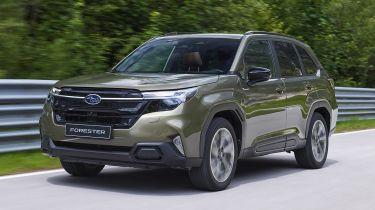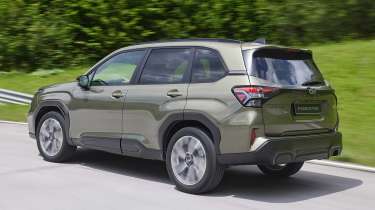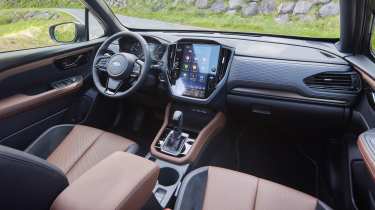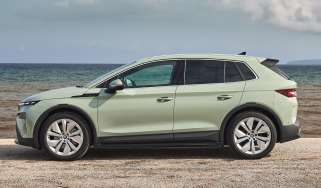New Subaru Forester 2024 review: improved tech but sole engine lacks power
The new Subaru Forester SUV is an improvement over its predecessor, but is let down by a lack of powertrain options

Verdict
The rating we’ve given the new Subaru Forester here comes with the caveat that our test drive was short and prices are still to be confirmed. What is clear is that a smarter exterior design, neater cabin and faster in-car tech will bring appeal to more buyers than ever. The level of engineering detail in the mechanical improvements is admirable, but on first impressions, the single powertrain option doesn’t quite offer enough performance or economy to raise the bar. That aside, it’s a comfortable, safe and well built SUV with decent off-road ability; if the price is right, then a full UK drive could confirm it offers enough to help it stand out in a crowded market.
This is the new Subaru Forester, and the sixth generation of the brand’s rugged SUV finds itself walking a fine line.
First of all, it needs to appeal to its fiercely loyal Subaru customers, many of whom have bought the brand’s products for years. It’s easy to see why so many buyers are keen to stay; long before Subaru’s WRC exploits gained it motorsport immortality, the Japanese company had already forged itself a reputation for bulletproof reliability. And that’s still the case today; in 2024, Subaru finished top in our Driver Power customer satisfaction survey for brands, with owners citing superb dependability and build quality among their cars’ many strengths.
More reviews
Car group tests
In-depth reviews
Road tests
- New Subaru Forester 2023 review
- New Subaru Forester e-Boxer 2020 review
- Subaru Forester 2.0 XT 2016 review
- New Subaru Forester diesel 2015 review
Used car tests
It makes perfect sense to please the existing customers’ desires for safety, durability and capability when they make up 43 per cent of the brand’s sales. However, those buyers are also ageing, with 39 per cent of them aged between 60 and 69, so it’s clear that changes need to be made to attract a new audience. The sort of alterations that can help to steal sales from more mainstream alternatives such as the Volkswagen Tiguan and Hyundai Tucson.
The first steps that should appeal to a wider group of buyers comes on the outside, where the new model gets a much cleaner, more modern face than its predecessor. There’s a smart design at the rear, too, with shallower bumpers that are designed to make boot access a little easier, while chunky, squared-off wheelarches give a tough look to the flanks.
From here, it’s clear that the newcomer’s silhouette looks very similar to the fifth-generation Forester, and that’s because under the skin, the new car takes its predecessor as a starting point. However, the engineering changes go deep enough for Subaru to consider it a new model.
That includes the bodyshell itself. Redesigned structural components and more than three times as much bonding adhesive than before make the structure lighter and 10 per cent more rigid. These steps, plus other small detail changes, such as mounting the seat rails directly to the chassis rather than through brackets and extra sound proofing materials (especially in the roof), have improved comfort and refinement, which was already one of the Forester’s strong points.
The SUV carries over the previous 2.0-litre four-cylinder petrol engine in the brand’s famous ‘boxer’ configuration, but unusually for a new car, it actually makes less power than the unit that came before. Power, previously at 148bhp, is down to 134bhp, and torque drops slightly from 190Nm to 182Nm.
Those decreases are partly down to new exhaust particulate filters to ensure emissions compliance, but beyond that there are a huge number of changes to the engine. New cylinder blocks, mounts, piston rings and camshafts, plus small ancillaries, ECUs and engine mounts have been adopted, primarily to improve reliability even further, but also to make the unit smoother, quieter and more efficient than before.
The hybrid portion of the powertrain has also been changed for the same reason. There is now an electric motor with 16bhp and 66Nm linked to a 0.57kWh battery, but the changes to its responses are also designed to improve the powertrain response.
We had a chance to put all of these adjustments directly to the test, because Subaru provided a previous-generation Forester with which to make back-to-back comparisons. Our time behind the wheel of each was very brief and limited to the confines of on and off-road test tracks, but it was enough to see that some of the changes had their desired effects.
Over cobbled and washboard sections of road, the new car had reduced side-to-side motions of the body over bumps, and the harshest portions didn’t shake the cabin as much. This was despite the fact that the newer car rode on 19-inch wheels and slimmer tyres than the old car that had 18-inch rims. Changes to the electric power steering have delivered a more natural, precise response, if only slightly. It also no longer clunks at full lock like the previous model did.
Officially, the 0-62mph time has increased from 11.8 to 12.2 seconds, but the impression at low speeds is that the reverse is true; the throttle pedal is less lethargic when moving off, because there is more electrical assistance kicking in sooner. Under hard acceleration, the engine note is more distant and less harsh, too, which is always a bonus for a car with a CVT automatic gearbox. While the power delivery is impressively smooth, some buyers who are used to the performance offered from rival products will be left hoping for a little more go.
We didn’t drive the car anywhere near far enough to fairly assess fuel consumption, but officially those powertrain changes – plus aerodynamic tweaks to the body and underfloor area – bring a mild improvement of 0.2mpg on the WLTP combined cycle. That only lifts the figure to 34.9mpg, though. That’s some way behind diesel and full-hybrid rivals, many of which also offer better performance.
There is the mitigating factor at play here, though, and that is that the Forester features permanent four-wheel drive as standard. This is an SUV that will genuinely get well off the beaten track without any worries, thanks to a range of exterior cameras, clever traction- control systems, and hill-descent control (it’s a touch more grabby on the brakes than the equivalent Land Rover system, but still impressive) allowing it to reach places that a Tucson would struggle. These systems now also work in reverse for the first time, so there are fewer excuses than ever for getting stuck.
As with its off-road ability, the build quality of the old car was never in question. The new Forester continues that, but introduces a significantly smarter cabin design, too. An 11.6-inch portrait touchscreen, much like the system fitted to the smaller Crosstrek, replaces the slightly messy layout of the old car’s dashboard, with new trim pieces and materials across the rest of the dash and door panels. It’s not quite on a Peugeot 3008’s level of poshness, but it looks smart while feeling sturdy.
It’s a shame that the old car’s rotary climate controls have gone; you still get big buttons to adjust the temperature, but all other heating and cooling functions have moved onto that screen. Further back, the cabin still offers loads of space in the back, and there’s also a vast 508 litre boot that expands to 1,732 litres with the rear seats folded.
Along with reliability, Subaru has built up a strong reputation for safety, too. The old Forester achieved a five-star Euro NCAP rating in 2019, including a superb Adult Occupant Protection score of 97 per cent. But beyond the passive safety design, the firm’s EyeSight ADAS technology has also played its part.
A total of 15 separate systems are fitted here, and five of those, including one that can drive and stop the car on a safe section of road if the driver becomes incapacitated while using the adaptive cruise and self-steering tech, are new to the latest Forester. Seven of those systems are improved on what came previously, including a wider-angle camera that helps improve visibility when pulling out of tight junctions.
The Forester is due to go on sale in the UK in the spring of 2025. Prices are still to be confirmed, but they’re expected to start from slightly more than the current car, which kicks off from £37,995. Subaru’s customer base means that many of its buyers pay with cash than the PCP finance deals that are more common across the whole UK market, but we feel like some punchy deals will be needed to create a new generation of loyal Subaru fans.
| Model: | Subaru Forester |
| Price: | From £40,000 (est) |
| Powertrain: | 2.0-litre 4cyl MHEV |
| Power/torque: | 134bhp/182Nm |
| Transmission: | CVT auto, four-wheel drive |
| 0-62mph: | 12.2 seconds |
| Top speed: | 117 mph |
| Economy/CO2: | 34.9mpg/183g/km |
| On sale: | Spring 2025 |
| Size (L/W/H): | 4,670/1,830/1,730mm |










